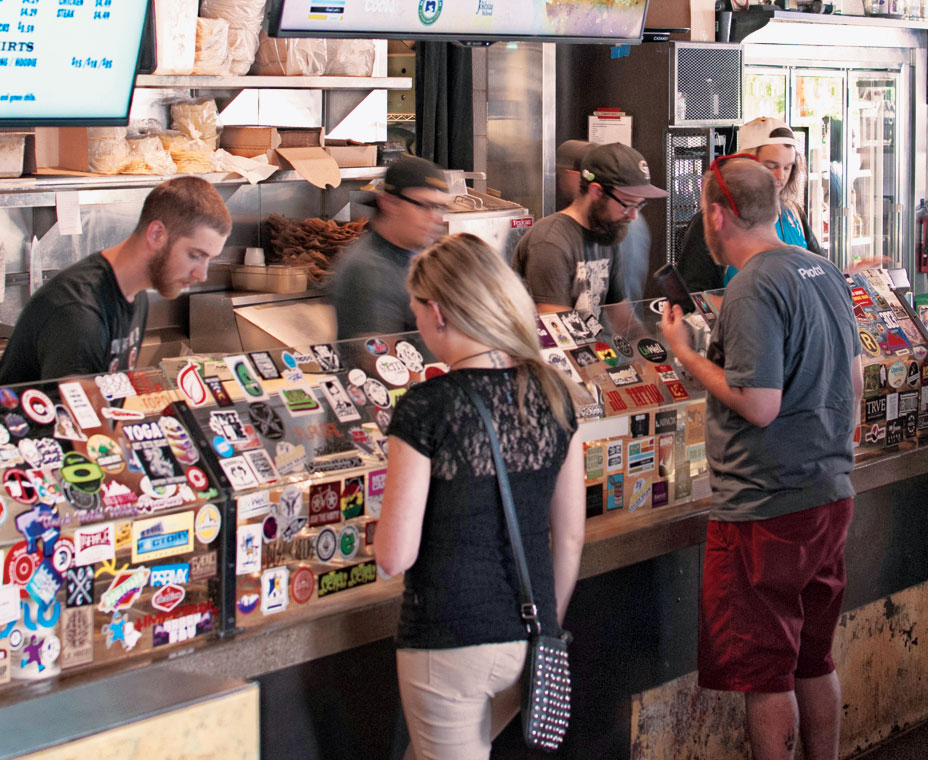Guests placing an order at Jersey Mike’s can pay for their meal in a variety of ways: credit card, Apple Pay, Google Wallet, online through a delivery-ordering system, through their mobile phones, and more. The New Jersey–based sub sandwich chain prides itself on being aware of upcoming digital technologies and is always trying to move customers through the line faster, says Jersey Mike’s CMO Rich Hope.
But that doesn’t mean the company is thinking of going cashless.
“Cash is still a viable method in this country, and I don’t think we intend to eliminate it anytime soon,” Hope says, adding that at Jersey Mike’s, cash transactions are often faster than credit-card ones.
Cash has its advantages. It doesn’t come with a service fee, it might encourage tipping, and it requires human interaction that can shine a light on superior customer service, says Virgil Dickerson, marketing manager of Illegal Pete’s, a Denver-based burrito concept that had considered going cashless but decided against it. The brand is, however, incorporating more digital payment options than just credit cards.
Despite the media buzz around restaurants going cashless, those brands comprise a very small percentage of the overall market. The largest chain to have made the transition might be Sweetgreen, which made headlines when it stopped taking cash last year. Around the same time, Visa launched an incentive program that would pay restaurants thousands of dollars to go cashless.
There are enticing elements to a cashless system, says Chris Francis, vice president of market development at WorldPay, which provides payment-processing solutions for businesses. It can be more secure with no risk of human error in calculating change and no physical money on hand for robbers—though hacking risks still exist.
Cashless transactions can also streamline the payment process, requiring fewer workers and less equipment. Some even claim cash payments take more time than card or mobile ones; Sweetgreen co-CEO Jonathan Neman told the New York Times that by not dealing with cash, “employees can perform 5–15 percent more transactions an hour.”
As Dickerson points out, cashless might seem like the way of the future. Nevertheless, it doesn’t look like the future is now.
“We talk with new technologies all the time,” Dickerson says. “I think we’re getting closer [to a cashless market]—a lot of change has happened, but I’m not ready to give up on cash just yet. I don’t feel like everyone is comfortable with all the technologies you have to use to go cashless.”
Cash’s continued use is a core reason to keep it in the limited-service space. For example, it’s around 20 percent at Illegal Pete’s. In contrast, Sweetgreen was processing fewer than 10 percent cash transactions, Neman told the New York Times.
The difference in those numbers reveals the most important consideration for brands flirting with the idea of going cashless or implementing any other type of alternative payment system: if it’s the right move for their customer base.
It’s a highly individual decision and should be customer-driven, Francis says. As a result, the shift to cashless, and even to accepting more forms of digital payments, is going to be uneven across demographics and across the country, he adds.
“There are still a lot of pockets of the U.S. where cash or even checks are very commonly accepted. [Going cashless] will vary greatly according to demographic, location, if customers are older or younger, if they are on the coast where they are more familiar with technology, or if they are in the heartland where folks tend to use what they know and are content with it,” Francis says.
But even for brands in urban areas chock full of young people, getting rid of cash could be alienating. “I think of people like my mom and people who are resistant to technological changes, and we want them to feel comfortable at Illegal Pete’s,” Dickerson says. He adds that the brand also draws some countercultural customers who eschew being part of the “system” and avoid traditional banks or credit-card companies.
Beyond those value-driven factors, cash provides an alternative should customers forget their credit card or phone.
For Washington, D.C., farm-to-taco fast casual Chaia, the accessibility that comes with accepting cash is fundamental to the brand values of community-oriented inclusiveness. “Almost 12 percent of D.C. households are unbanked, and another near 25 percent are under-banked,” says cofounder Bettina Stern in an email. “That’s almost 36 percent of the District’s population. Plus, there are simply those folks that don’t have a credit card. We have recognized how important it is to serve all of our customers.”
Despite some variance across geography and income levels, transactions are, overall, becoming more cashless organically. Just five years ago, half of Jersey Mike’s transactions were paid with cash; today it’s closer to 35 percent. That change is largely attributable to millennials, who, Hope says, are more comfortable than older generations using their credit cards for even small purchases.
But while millennials like credit cards now, they can be fickle, Francis says. They may convert to something like Apple or Samsung Pay. They also like person-to-person payment app Venmo, which is exploring commercial applications.
For Jersey Mike’s, that’s another reason not to go cashless. “I think credit cards are short lived,” Hope says. “In a very short period of time, we’ll just be carrying our mobile device.” That’s ultimately why Jersey Mike’s is concentrating on mobile payments and online orders. “We want people to come in and pay with whatever method works best for them.”












